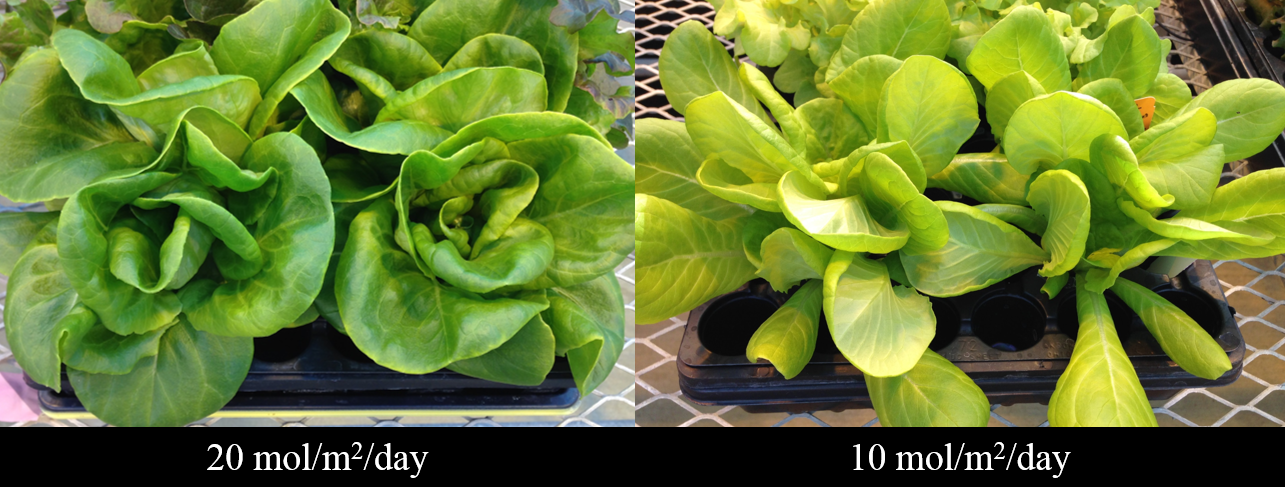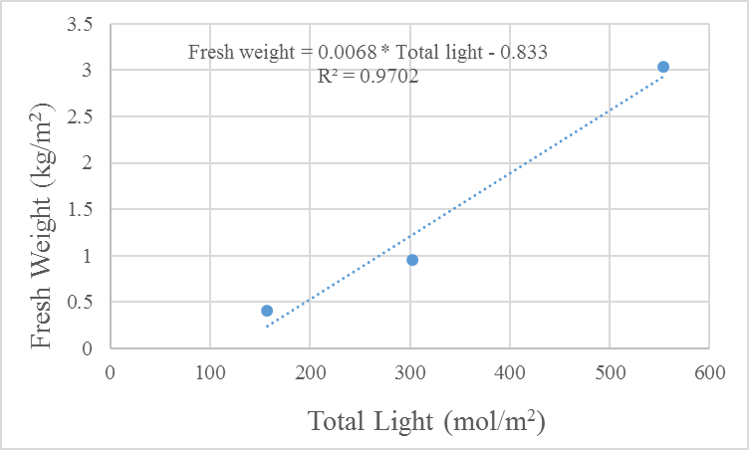Krishna Nemali and Petrus Langenhoven (plangenh@purdue.edu, 765-496-7955), Department of Horticulture and Landscape Architecture, Purdue University
A question many growers are asking is whether supplemental lighting is profitable for hydroponic lettuce production during the winter. We will address this specific question in this article. Light requirement (daily light integral, DLI) of lettuce can vary from 15-20 mol/m2/day. In Indiana and surrounding regions, lettuce is grown in greenhouses during the winter for year-round supply to consumers. The DLI received inside the greenhouse during the winter from sun light is approx. 5 mol/m2/day in these regions. Lettuce grown under low DLI has slow growth rate (i.e., takes longer to harvest) and appear poor in quality (elongated).

Figure 1: Differences in the size and appearance of lettuce grown at 10 and 20 mol/m2/day
So, how do you know if supplemental lighting is economical for winter lettuce crop? We will require the following two pieces of information to answer the question: (i) What is the additional cost of a mole of supplemental lighting, and (ii) What is the additional benefit in terms of the value of crop produced from a mole of supplemental lighting.
To determine the cost per mole of supplemental lighting, you will need information on how much light intensity (µmol/m2/s) is received right above the plants from supplemental lighting (alone) and how much power (or electrical input in ‘watts or joules/s’) is used by the lamps. The ratio of these two, i.e., light intensity received to power used is called ‘photon efficiency’ (µmol/J). Information in Fig. 2 can be used to calculate the cost of supplemental lighting per mole of added light using photon efficiency (shown on x-axis) assuming the cost of electricity at 10 cents per unit. For example, to keep the cost of adding a mole of supplemental light below 3 cents, the photon efficiency of the fixture should be above 1 µmol/J.

Figure 2. Relationship between cost of electricity (cents) per mole of added light and photon efficiency of the lamp and fixture
If you already installed supplemental lighting, I suggest you measure photon efficiency at your location for accuracy. If you are planning to buy supplemental lights, the information on photon efficiency can be obtained from the manufacturer. Before buying, you should make sure to ask or learn about the distance between the lamp and light sensor that was used to calculate photon efficiency by the manufacturer. Often, manufacturers use small distances between the light sensor and lamp while generating specifications, which may be quite different for your location. This can be misleading and cause errors in your analysis.
Next, we need to determine the additional benefit in terms of added value of crop produced from a mole of supplemental light. To obtain this information, we grew 15 varieties of lettuce under three daily light integral regimes of 5.6, 10.8 and 19.8 mol/m2/day for 28 days, or a total of 157, 302, and 554 mol/m2 of light during the growth. The average fresh weight of all varieties was 0.41, 0.95 and 3.04 kg/m2 at harvest in the 5.6, 10.8 and 19.8 mol/m2/day treatments, respectively. Using a regression between the average weight and total light received (Fig. 3), we estimated that lettuce can produce an additional fresh mass of approx. 0.0151 lb (or 6.8 g) for every mole of light incident on the plants (note the slope of the line in the graph). Slope of the line in the equation (i.e., 0.0068 kg or 6.8 g or 0.0151 lb) indicates the average weight produced per mole of light. Similar to our results, Kubota et al. 2016 indicated that lettuce produces 3.7 – 6.9 g/mol of light received by plants. Multiplying the average price per lb of fresh lettuce (this is your selling price per lb) with 0.0151 lb/mole will give the added value (in cents) of lettuce produced per mole of added light.
A decision to add or use supplemental lighting can be made with the information on the cost and benefit of adding a mole of light. Note that we have not used the cost of fixtures and installation here. These costs should be included, however in estimating profits for a long-term.
We hope that you can use the information in this article to calculate the electrical cost of adding one mole of supplemental light and added value of crop produced from a mole of supplemental light to determine if supplemental lighting is economical to your situation. An important thing to keep in mind is that just adding extra light will not be enough; you have to make sure that other growing conditions are optimal as well.

Figure 3: Relationship between average fresh weight (kg/m2) of 15 varieties of lettuce and total light (moles) received per m2 during the growth.
Reference:
C. Kubota, M. Kroggel, A.J. Both, J.F. Burr and M. Whalen. 2016. Does supplemental lighting make sense for my crop? –empirical evaluations. Acta Hortic. 1134: 403-411